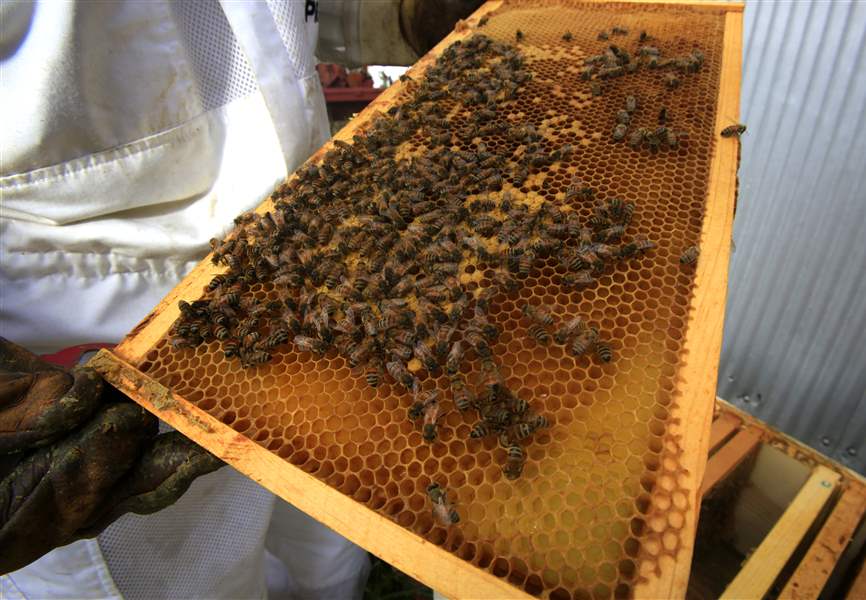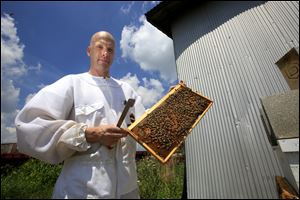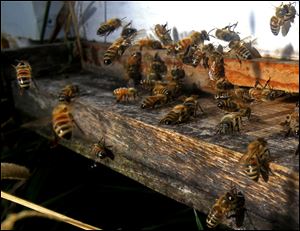
Bee essentials: Experts focused on keeping pollinators buzzing
8/7/2017

Honeybees swarm on a comb. More than 500 native species of bees hail from Ohio.
The Blade/Kurt Steiss
Buy This Image
There are about 22,000 species of bees in the world. Between 3,000 and 4,000 make their home in the United States, and, of those, a little more than 500 native species hail from Ohio.
On a recent hot summer day out in Riga, Mich., one of those natives, a bumblebee, came careening near James Case and smacked into the veil of his bee suit before buzzing away.
“What are you doing here?”

Honeybees swarm on a comb. More than 500 native species of bees hail from Ohio.
When he was pelted by the bumblebee, Mr. Case was examining his own stock of bees — at this site, six hives of honeybees, initially European, but from populations that had been around North-west Ohio and Michigan long enough to be dubbed “local mutts.” Despite their mutual bee-ness, bumblebees and honeybees don’t often fraternize, prompting Mr. Case’s mild consternation.
That day, the bees were calm and, as far as he could tell, healthy. He had just grafted four specially bred “ankle-biter” queens to his hives, which are more “hygienic” than normal bees. They like to nibble on wood and on the legs of varroa mites, a pest that has ravaged bee populations in recent years.
Mr. Case of Sylvania has been keeping bees for six or seven years. He started right as a wave of mysterious hive die-offs that began in the mid 2000s — dubbed “Colony Collapse Disorder,” or CCD — was subsiding.
“I’ve heard people talk about losing 60, 70, 80, 90 percent of their hives in the space of a couple of years,” he said.
Today, he thinks beekeeping is “coming out of a bad place, but starting to stabilize.”
Bee roles
Though the hive-dwelling, honey-producing domesticated European honeybee looms large in the popular imagination, these bees are far from typical. In fact, most bees live in the ground, and many are wild and solitary. Even the more social bees, such as the bumblebee, live in much smaller colonies: Bumblebee colonies can be as small as 50 individuals, and never approach the tens of thousands, like large honeybee colonies do.
Many bees are solitary, including the native squash bee, the most effective pollinator for melons, squash, cucumbers, and pumpkins. Without insect pollination services, these major Ohio cash crops would fail.
No major staple crop relies on bee pollination, but bees are integral to many significant crops.
Professor Reed Johnson studies domestic bee populations at Ohio State University.
“Today, beekeeping is a national agricultural enterprise,” he said. “Ohio is in the middle of all these migratory routes.”

James Case, who has been keeping bees for six or seven years, examines one of his six hives of honeybees in Riga, Mich.
Every year from February to March, more than 1.5 million honeybees make their way to California to pollinate the blooming almond trees, which are reliant on bees to produce fruit.
“I don’t know how many semi-truck loads of bees that is. It’s quite a logistical feat,” Mr. Johnson said.
According to researchers at the University of California-Davis, California has more than 800,000 acres of almond trees and each acre requires two honeybee hives to be completely pollinated.
Some bees, such as the blue orchard mason bee, a solitary and metallic-hued creature which makes its nests out of clay, are more effective pollinators of fruit trees at the individual level.
But when it comes to pollinating hundreds of thousands of acres, quantity has a quality all its own. Industrial-scale agriculture requires industrial-scale beekeeping.
“A honeybee hive is 20,000 bees in a movable box. You can’t beat that,” Mr. Johnson said.
And bees are helpful, if not essential, for Ohio’s 4.5 million acres of soy beans. Though wind-pollination is sufficient for adequate soy bean harvests, bee pollination leads to appreciable yield increases.
“They’re both just so important for Ohio’s landscape,” the researcher said. “They’re natural allies.”
Beeline for habitats
Which is not to say that Ohio’s human residents have always been kind to the landscape or the bees. In late March, the rusted patch bumblebee was listed as endangered by the U.S. Fish and Wildlife Service. Karen Goodell, a professor at Ohio State University, is surveying rusted patch populations in all 88 of Ohio’s counties.
“We don’t know whether it’s gone extinct in Ohio or just dropped to a very low population density,” she said.
Though there is no clear verdict as of yet about the cause of CCD, neonicotinoids — once common pesticides — are a prime suspect. There are clear indications that the pesticide kills bees and alters their behavior.
“With pesticides, the situation for bees is much better. The FDA and the chemical companies had a major rethinking, kind of spurred on by CCD,” Mr. Johnson said.

Bees swarm at one of James Case's beehives in Riga, Mich.
But even the rare healthy and pesticide-free bees can’t survive without the proper environment.
“That normal, ideal green lawn which everyone wants, with no weeds — that’s a desert for bees,” James Case said. “And these huge swathes of corn are really bad for them too.”
These swathes are part of the “monoculture” problem, he continued, referring to the use of a single crop in an area. Pollinators, like bees and butterflies, need appropriate habitats with sources of nectar and pollen to thrive.
Across the state, local beekeepers, scientists, and wildlife enthusiasts are working to shore up bees and other pollinators and engage the public in their preservation.
Marci Lininger, a biologist with the Ohio office of the U.S. Fish and Wildlife Service, also leads the Ohio Pollinator Habitat Initiative.
“What we’re trying to do is reconnect the Ohio landscape,” she said. “A lot of our puzzle pieces are missing, so we’ll have to rebuild it in a sort of fragmented way. “
The initiative, a network of nonprofits and government agencies, takes a “resource-based” approach to conservation. Recently, a local chapter of the Wild Turkey Federation approached the initiative about turning a local vacant lot into a pollinator habitat. The initiative pooled the resources of the Department of Transportation, the Fish and Wildlife Service, and others to get the job done.
Meanwhile, scientists are working on repurposing one of mankind’s most disruptive innovations — cities — into fruitful ground for pollinators.
In Cleveland, professor Mary Gardiner of Ohio State University has turned 27 vacant lots into “pocket prairies” blooming with wildflowers and other pollinator delicacies to evaluate how to support urban bee populations.
Katie Todd, one of her graduate students, is studying the diets of these bees with novel X-ray technology, and has developed an entomology program for children with the local 4-H.
“I’m from Ohio,” Ms. Lininger said. “I want to see the state do good for the next generation, for kids that want to see monarch butterflies, want to see bees in the wild.”
Contact Victorio Cabrera at vcabrera@theblade.com, 419-724-6050 or on Twitter @vomcabrera.